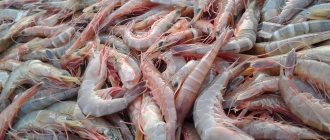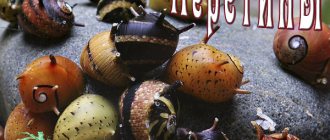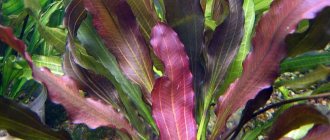Among the omnivorous crustaceans, the aquarium shrimp stands out, which has good endurance. This variety of representatives of the underwater world is so graceful that recently more and more aquarists have been breeding aquarium shrimp. The unique shape and variety of colors make the shrimp a welcome guest in any aquarium.
Among the omnivorous crustaceans, the aquarium shrimp stands out, which has good endurance.
general characteristics
Homemade shrimp in an aquarium look very aesthetically pleasing and are a decoration for any artificial tank . There are a huge number of species of these crustaceans of all kinds of colors. Many species are quite accessible to aquarium owners. But there are very large aquarium shrimp of rare and valuable species, the cost of which is fabulous.
Appearance
Several segments make up the body of a shrimp. Each such department has its own limbs that perform various actions. The first three segments of the body have a shell that performs a protective function. The jaws, whiskers and mandibles are limbs.
The shrimp has a complex mouthparts of a certain size. It contains three pairs of jaws that grind food, which it holds with its jaws. The remaining five pairs of thoracic limbs are used by arthropods for crawling and catching prey.
To swim, they use abdominal legs called pleopods. Females use them when bearing eggs. And the first pair in males is the copulatory organ.
Habitats
Under natural conditions, these arthropods are found almost everywhere - both in salt water and freshwater. But each species has its own place of birth. For example, the Amano species comes from Japan, where it is found in mountain rivers flowing into the Pacific Ocean.
The birthplace of the rednose shrimp is Venezuela. In the Pacific Ocean off the coast of Panama, a fan-shaped species of these crustaceans is found. Babaulti's habitat is India. Most of the ornamental freshwater shrimp in the aquarium are native to Asia. In Russia, they live in the Far East, where there are more than 100 species. There are about two thousand species in their family.
In natural conditions, shrimp are found almost everywhere
Starting investment size
Investments depend entirely on the planned scale of production. Launching the first aquarium will cost approximately 20,000 - 40,000 rubles, and organizing a full-fledged shrimp farm with several ponds will require multimillion-dollar investments.
As an example, let’s take a farm with a closed water supply loop, which can be considered an ideal option for our climatic conditions. To accommodate such a farm, more than 150 m2 of production premises are needed - with a ventilation system, heated electrical and water supplies, as well as a sewerage system. You also need to buy a batch of 1,000 shrimp. Estimated costs are shown in the table.
| Expense item | Cost, thousand rubles. |
| Equipment | 730 |
| Shrimp (1000 pcs.) | 30 |
| Rent | 170 |
| Feed ration | 140 |
| Housing and communal services | 140 |
| Salary fund | 340 |
| Unexpected expenses | 50 |
| Total | 1 600 |
The annual costs for rent payments, purchasing feed, paying wages and paying for housing and communal services in this case will be approximately 850,000 rubles.
Maintenance and care
It is necessary to keep shrimp in an aquarium by following a number of rules . If you provide proper care for shrimp in the aquarium, they will delight the owner's eye for a long time. Their water should be oxygenated and clean. It is necessary to provide your tank with a filter and an aerator. We should not forget that they lead a bottom-dwelling lifestyle. Marble sand and pieces of limestone are perfect for arranging the bottom.
Water changes must be carried out every two days, but do this carefully. If the shrimp get nervous, then you need to stop adding liquid for 15 minutes and let them get used to the fresh portion of water.
The water temperature should not heat above 30 degrees, otherwise the crustaceans will die, and not fall below 15, as this has a bad effect on fertility. The pH of water should be normal or slightly acidic. The aquarium should be covered with a lid to prevent the inhabitants from crawling out. The presence of copper in water is detrimental to them.
Types of shrimp
When buying shrimp for an aquarium, you need to have a good understanding of the species to avoid problems in the future. Adults can be large, and the aquarium will not be spacious enough for them. In some cases they may turn out to be predators. Aquarists recommend the following species:
- harlequin;
- red crystal;
- Red cherry;
- amano;
- red-nosed
Harlequin is a very small species - a little more than 1 cm. They are red and white in color and very shy. The suitable water temperature for them is 25 degrees. They reproduce in fresh water without hatching larvae. They bear offspring within a month. On average, one and a half dozen small cubs are born.
Harlequin is a very small species - a little more than 1 cm
The Red Crystal is a very beautiful white shrimp with red stripes. She is picky about the quality of water, the temperature of which should not exceed 26 degrees. This species should not be overfed.
The most popular is Red Cherry due to its very bright color and trouble-free propagation. They are completely unpretentious in maintenance and easy to care for. Males are half the size of females, which can reach 4.5 cm.
The most popular species of shrimp is the red cherry shrimp due to its very bright color and trouble-free reproduction.
Amano is green in color with a light stripe on the back and dark spots on the sides. They are very useful in the aquarium as they are “cleaners” that destroy unwanted plants and algae. These arthropods are non-aggressive, but difficult to breed. To get offspring, the female must be placed in a separate container, where the water temperature must be maintained at 23 degrees. A filter, a lamp and aeration must be installed in this reservoir. A couple of days after the fry are born, they should be moved to another aquarium with brackish water.
The Rednose's distinctive feature is that it swims rather than runs. This species also belongs to the “cleaners”. They can live in both fresh and salt water. They got their name because of their red nose. They cannot tolerate the presence of predators in the aquarium. Their maximum size reaches 4 cm.
Habitat in nature
In fact, it is a color variation of common neocardinas, bred by selecting and enhancing the bright colors. Neocardines are distinguished by their inconspicuous, camouflage coloring, which is not surprising; they cannot survive with cherry blossoms in nature.
By the way, neocardines live in Taiwan, in freshwater bodies of water, and are distinguished by their rare unpretentiousness and speed in breeding. These were the first of the shrimp that began to appear in large quantities in the post-Soviet space, but gradually they gave way to cherry shrimp.
At the moment, shrimp lovers have developed a whole quality classification, which is based on the size and color of the individual; elite cherry shrimp sometimes cost a lot of money.
Feeding crustaceans
Shrimp are omnivorous. They are constantly in search of food. They feed on dead parts of plants, gnaw algae and fish corpses. They should be fed every other day, and it is better not to do this on the day when the water is changed. They tolerate stress better when they are hungry.
Suitable food for aquarium shrimp:
- dry daphnia;
- any live food;
- tablets with spirulina;
- bloodworm;
- cod meat;
- dry vegetable flakes;
- Artemia;
- tubifex
A feature of their diet is the need for a balanced diet containing calcium. When they grow, they constantly molt and, due to a lack of calcium, begin to eat their shell, which they just got rid of.
A special feature of shrimp nutrition is the need for a balanced feed containing calcium.
What to feed
As a rule, there are no problems with feeding shrimp. The undoubted advantage of this crustacean animal is its omnivorous nature. In its natural habitat, the shrimp's food includes moss, algae, plant leaves, small fish, and sometimes even its own shell.
But there is another serious problem caused by cannibalism. These representatives of the crustacean families (although not all, but only some subspecies), with a lack of nutrition or overcrowding of the reservoir, may well eat their own kind. It is in order to avoid such adverse consequences that it is recommended to use spacious tanks or artificial reservoirs for breeding, as well as to provide the shrimp with a sufficient number of reliable shelters.
A properly balanced diet will help prevent cannibalism and accelerate the growth and development of shrimp. Experts recommend including both dry granulated food and live food (for example, Artemia larvae) in the daily menu. This option (a combination of live and ready-made food) allows you to diversify the diet and provide the shrimp with all the nutrients and elements they need. Of course, preference is always given to live food, but using only one will be extremely expensive for the shrimp owner.
You can prepare high-quality dry food yourself at home. To do this, simply combine in equal proportions such components as plankton, egg powder, crushed algae, milk powder, fish oil, and fortified supplements. The resulting mixture is dried and then ground to a powder. This food has a high nutritional value, a high content of protein and vitamins, and can also be stored for a long time, which is extremely convenient.
Considering the omnivorous nature of shrimp, they will always be able to find additional food for themselves by consuming algae, leaf plates of underwater and surface crops. Such nutrition will be very useful for pets, so it is important to decorate the aquarium with plants and provide sufficient lighting for their active growth.
It is recommended to feed shrimp once every 2-3 days to avoid overfeeding and obesity, disruption of deceptive processes and other diseases.
During the breeding or molting period, the animal's need for protein and other nutrients will especially increase, so the shrimp are transferred to daily feeding, offering food 1-2 times during the day.
An interesting feature, characteristic exclusively of shrimp, is that for quite a long time they can do without food at all, feeding on organic microparticles that are invariably present in any artificial reservoir. This is a very valuable quality that allows the owner of shrimp to go away for several days or even 2 weeks without fear for the condition of their pets.
Conditions for reproduction
If you create favorable conditions, the reproduction of aquarium shrimp will not cause any problems. To do this, you need to create a secluded corner in the aquarium with Java moss and small-leaved plants.
As soon as the shrimp become active and chase each other, it means that the female has reached puberty, and mating games have begun . Sometimes she goes to several males and then bears large offspring. The greenish mucus under the tail is eggs. Small, translucent shrimp can be seen maturing. When the visual apparatus is formed during gestation, black eyes in the eggs will be visible.
On average, after 5 weeks, the eggs hatch into larvae. This process is very entertaining. Different species do not interbreed.
Currently, shrimp farming in aquariums is popular.
Compatibility
Extremely peaceful representatives of the underwater world. Compatible with many related species and calm small fish. Avoid keeping with large aggressive or predatory fish. Although different varieties of shrimp do not conflict with each other, an undesirable side effect is possible, namely cross-breeding and, as a result, the population degenerates into ordinary, unremarkable shrimp.











